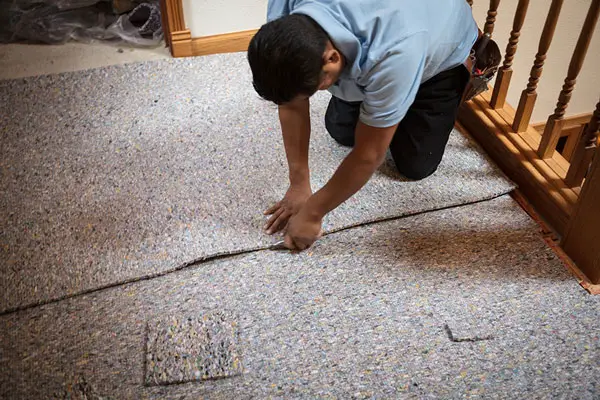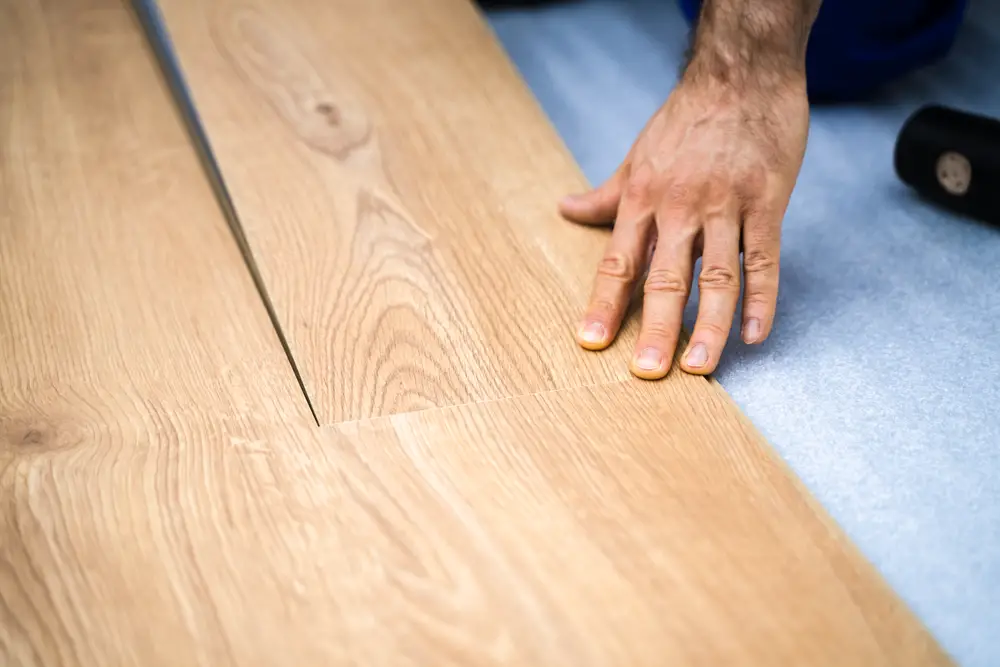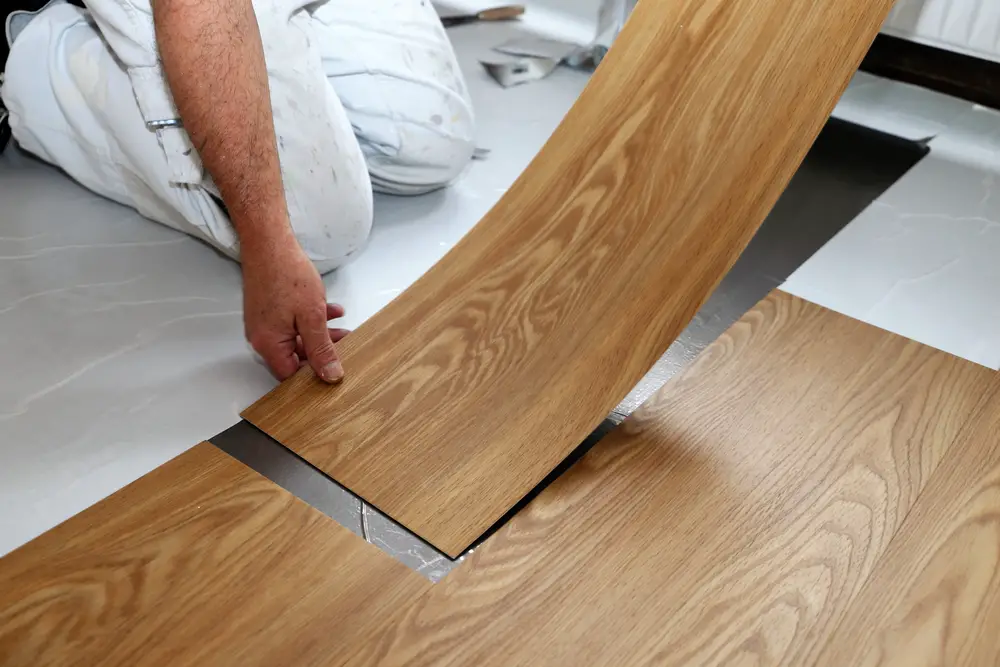When it comes to home improvements, one frequently asked question is: “What kind of flooring can you put over carpet?” While traditional approaches often involve removing the carpet before laying a new floor, there are several innovative solutions today that allow homeowners to install flooring directly over the existing carpet.
This article aims to provide comprehensive insights into the different types of flooring that can be installed over a carpet, addressing various aspects such as installation procedures, costs, pros, and cons. Let’s explore the possibilities for your home improvement plans.
Choosing the right flooring is a critical aspect of home improvement. It not only enhances the aesthetic appeal of your space but also contributes significantly to its functionality and longevity.
The right flooring can withstand wear and tear, reducing the need for regular replacements or repairs, and hence, saving costs in the long run. Moreover, it has a direct impact on the comfort level of your home.
Hence, it’s essential to consider factors such as durability, maintenance, cost, and design when selecting flooring.
Carpet as a Subfloor

Carpet, when used as a subfloor, offers a unique set of characteristics that can influence the choice of top flooring. One of the most significant advantages of a carpet subfloor is its natural cushioning effect.
The physical structure of carpeting creates a soft, padded underlayer that can provide added comfort and noise reduction, especially in high-traffic areas.
Another characteristic of carpet as a subfloor is its insulation properties. Carpets are excellent insulators, providing warmth during colder seasons and keeping the room cooler during hotter months.
This thermal resistance can result in energy savings over time.
However, there are some drawbacks to carpet subflooring as well. Carpets can trap dirt and allergens, making them a potential health concern, particularly for those with allergies or respiratory conditions.
Furthermore, carpets are prone to moisture absorption which can lead to mold and mildew growth if not properly maintained.
Lastly, it’s important to consider the thickness of the carpet. While a thin, low-pile carpet can act as a reasonable subfloor, a thick, high-pile carpet can create an uneven surface, making it challenging to install certain types of top flooring.
Challenges and Considerations
When leveraging carpet as a subfloor, several challenges and considerations can arise. One of the primary challenges is the potential for moisture retention. This can make a carpet subfloor unsuitable for damp or humid environments, or in rooms where water spills are likely, such as bathrooms or kitchens.
Additionally, the cleaning and maintenance of carpet subfloors can be labor-intensive. Regular deep cleanings are necessary to prevent the buildup of allergens, dust, and dirt.
The use of certain cleaning solutions or techniques may also be restricted to avoid damaging the carpet fibers or causing discoloration.
From a design perspective, the choice of carpet as a subfloor can limit the types of top flooring that can be installed successfully. For instance, hard and rigid surfaces such as tiles may not adhere well to the soft and flexible carpet subfloor.
Therefore, detailed consideration must be given to the compatibility between the chosen carpet subfloor and the intended top flooring.
Lastly, budget considerations can also play a role. Although carpet can be a less expensive option initially, the costs of regular maintenance, and potential replacement due to wear and tear, can add up over time.
Types of Flooring That Can Be Installed Over Carpet
Laminate Flooring

Laminate flooring is a popular choice to be installed over carpet due to its design flexibility and durability.
Laminate flooring is composed of several layers which include a moisture-resistant layer, a high-density fiberboard layer, and a high-resolution photographic image layer that can replicate the appearance of various materials such as wood, stone, or ceramic.
The top layer is a clear, hard-wearing layer that provides resistance to scratches and stains. This composition makes laminate flooring a versatile and long-lasting choice. When installing laminate flooring over carpet, it’s crucial to ensure the carpet is thin, low-pile, and firmly affixed to the subfloor.
An underlayment may be necessary to provide stability, prevent moisture ingress, and enhance the performance of the laminate flooring.
Vinyl Flooring

Vinyl flooring is another excellent option for installation over carpet, owing to its resilience and maintenance ease. Similar to laminate flooring, vinyl also provides a variety of design options, effortlessly mimicking materials like wood, stone, or ceramic, but at a more affordable price point.
This flooring type is comprised of a backing material for strength, a print layer with the desired pattern, and a wear layer that offers protection against scratches and dents.
One significant advantage of vinyl flooring is its inherent water resistance, making it suitable for areas prone to moisture like bathrooms and kitchens. When installing vinyl over carpet, it’s essential to remember that, as with laminate, the carpet has to be low-pile, and securely fastened to the subfloor.
Additionally, an underlayment may be required to reduce the risk of any carpet texture or imperfections showing through the vinyl.
Interlocking Tiles
Interlocking tiles are an innovative and flexible option for flooring over carpet. These tiles feature unique edges that allow them to fit together like puzzle pieces, creating a cohesive and robust floor surface.
Typically made from durable materials like vinyl, rubber, or wood, interlocking tiles are renowned for their ease of installation and removal, making them an ideal temporary flooring solution.
They are also incredibly versatile and come in an array of colors, patterns, and textures, enabling homeowners to customize their floor aesthetic to fit their style. While installing over a carpet, it is recommended to use an interlocking system that clicks or snaps together, providing a secure fit without any need for adhesives.
It’s important to ensure the carpet underneath is low-pile and tightly affixed to the subfloor to prevent any movement or shifting of the tiles.
Procedure for Each Type of Flooring
Installing Laminate Over Carpet
Installing laminate flooring over carpet can be a practical and cost-effective solution, but it requires careful consideration and precise execution. Here is a simple step-by-step guide to help you install laminate over carpet:
Inspect the Carpet:
The first step is to inspect the carpet. Only low-pile carpets—like Berber—are suitable for this process. Deep piles or loose carpets need to be removed as they cannot provide the stable base required for laminate flooring.
Clean and Dry the Carpet:
Ensure the carpet is thoroughly cleaned and completely dry before proceeding. Any dirt or moisture can interfere with the process and impact the longevity of your laminate flooring.
Lay the Underlayment:
Even when installing over carpet, an underlayment is crucial. Its purpose is to provide cushioning, absorb sound, and act as a moisture barrier. Roll out the underlayment over the carpet, ensuring it is smooth and flat with no creases or bubbles.
Place the Laminate Planks:
Starting from one side of the room, begin placing your laminate planks. They should be laid end to end, ensuring the tongue of one plank fits into the groove of the next. Continue this process until the entire floor is covered.
Apply Finishing Touches:
Install baseboard molding around the perimeter of the room. This not only gives a finished look but also helps to keep the laminate floor in place.
Installing Vinyl Over Carpet
Installing vinyl flooring over carpet is a project that should be approached with caution, as it’s generally recommended to remove carpet before laying down vinyl. However, under certain conditions—specifically, when the carpet is low-pile and tightly affixed—it can be possible. Here’s a basic guide:
Assess the Carpet:
Like with laminate flooring, only specific types of carpet are suitable. This procedure should only be considered with low-pile, tightly affixed carpets. If the carpet is shaggy, loose, or plush, it should be removed before installation.
Ensure Cleanliness and Dryness:
Make sure the carpet is meticulously clean and thoroughly dry. Any dirt, dust, or moisture can compromise the adhesive used for vinyl and lead to lifting or shifting.
Lay Plywood Over Carpet:
To create a flat and solid base for the vinyl, lay a thin layer of plywood over the carpet. This should be done carefully, ensuring the entire carpet surface is covered.
Install the Vinyl Flooring:
Begin laying your vinyl flooring on top of the plywood, starting from one end of the room and working your way across. Ensure each piece is firmly pressed down to secure a good bond with the adhesive.
Finish the Installation:
Trim any excess vinyl at the edges and install baseboards or quarter-round to create a clean finish and prevent the edges from lifting. The addition of these moldings not only enhances the aesthetic but also adds to the stability of your new vinyl floor.
Installing Interlocking Tiles Over Carpet
Interlocking tiles can be a great flooring option to install over the carpet, especially when dealing with a high-pile or plush carpet where vinyl would not be suitable. Follow these steps for a successful installation:
Assess the Carpet:
Like with other floorings, not all carpets are suitable for interlocking tiles. High-pile and plush carpets are acceptable, but the carpet must be firmly attached to the floor with no loose areas.
Ensure Cleanliness:
Before you start, the carpet should be clean and free of any loose fibers or debris. Vacuum thoroughly to remove any potential foreign materials.
Layout the First Tile:
Start at one corner of the room and lay down the first tile. The edges of the tile should align with the walls.
Continue Laying Tiles:
Continue placing tiles, making sure the interlocking edges fit snugly together. Work your way across the room until the entire area is covered.
Trim Excess Tiles:
To fit corners and edges, some tiles may need to be cut. Always measure twice and cut once to ensure accuracy.
Check Stability:
Walk around on the tiles to ensure they are secure and there is no movement. The weight of the tiles and the interlocking mechanism should keep the floor stable, but if any sections shift, consider using carpet tape to secure those areas.
Remember, this is a temporary solution and may not last as long as traditional tile installations. However, it can be a quick and easy way to update a room without removing your existing carpet.
Related Topic:
Benefits and Drawbacks of Each Type
Laminate Flooring
Pros
- Affordability: Laminate flooring is typically more cost-effective than many other flooring options.
- Ease of Installation: Most laminate flooring comes with a click-lock design making it easy to install.
- Durability: Laminate is resistant to scratches, and also holds up well against wear and tear.
- Variety of Designs: Laminate comes in a wide array of colors, patterns, and designs, including options that mimic the look of hardwood or stone.
Cons
- Not Refinishable: Unlike hardwood, laminate cannot be refinished. If it’s damaged, replacement is the only option.
- Sound: It can produce a hollow sound when walking on, which might be off-putting to some people.
- Water Resistance: While it is more resistant to water than hardwood, standing water can seep into the seams and cause damage to laminate floors.
- Resale Value: Laminate flooring may not add as much to the resale value of a property as hardwood or tile would.
Vinyl Flooring
Pros
- Cost-Effective: Vinyl flooring is one of the most economical options available.
- Water Resistance: Vinyl is virtually impervious to water, making it a great choice for areas prone to moisture like bathrooms and kitchens.
- Durability: It is highly resilient and can withstand heavy foot traffic.
- Variety of Designs: Similar to laminate, vinyl also comes in a wide range of colors, patterns, and designs.
- Comfort: Vinyl floors tend to be more comfortable underfoot than many other flooring options.
Cons
- Environmental Impact: Vinyl is non-biodegradable and its production can release harmful chemicals into the environment.
- Susceptible to Damage: While durable, sharp objects can gouge vinyl flooring and heavy furniture can leave permanent indentations.
- Cannot Be Refinished: Like laminate, if vinyl is damaged, it typically must be replaced.
- Potential Health Concerns: Some types of vinyl flooring may off-gas volatile organic compounds, which may pose health risks.
- Resale Value: Similar to laminate, vinyl may not significantly increase the resale value of a property.
Interlocking Tiles
Pros
- Easy Installation: Interlocking tiles don’t require any adhesives or special tools for installation. The tiles simply snap together, making for a quick and hassle-free installation process.
- Versatility: These tiles come in a variety of materials, colors, and patterns, allowing for a high degree of customization.
- Durability: Interlocking tiles are designed to withstand heavy traffic and are resistant to impact, scratches, and stains.
- Easy Maintenance: They’re easy to clean and, if a tile gets damaged, you can simply replace that single tile instead of needing to replace an entire floor.
Cons
- Cost: Interlocking tiles can be more expensive than other types of flooring due to their quality and ease of installation.
- Uneven Surface: If the subfloor isn’t perfectly level, interlocking tiles can create an uneven surface.
- Water Resistance: Although they are generally water-resistant, water can seep through the seams if they are not locked properly.
- Limited Longevity: While durable, interlocking tiles might not last as long as some other flooring options, such as hardwood or stone.
Conclusion
Choosing the right flooring to be installed over carpet largely depends on your specific needs, budget, and aesthetic preference. Laminate flooring offers a cost-effective solution with great durability and a wide array of design options.
Vinyl flooring can be another favorable choice due to its resilience, easy maintenance, and water resistance. Meanwhile, interlocking tiles provide high versatility and ease of installation, although at a higher cost.
Each has its pros and cons, so consider your unique situation and requirements before making a decision. Remember to ensure the carpet is low pile and firmly affixed to the subfloor before installation, regardless of the flooring type you choose.
By making an informed decision, you can ensure that your new flooring will enhance the aesthetic appeal of your space while also serving its function well for years to come.
FAQs
What type of flooring is best for high-traffic areas?
Interlocking tiles and vinyl flooring are both well-suited for high-traffic areas due to their durability and easy maintenance. However, if cost is a concern, laminate flooring, while not as resilient, is a more budget-friendly option that still offers good durability.
Can I install these types of flooring over any carpet?
A: It’s best to install these types of flooring over low pile carpet that is firmly affixed to the subfloor. A high pile or loose carpet can lead to an unstable flooring surface. Always ensure the carpet is suitable for overlaying with other flooring types before proceeding with installation.


1 thought on “What Kind of Flooring Can You Put Over Carpet”